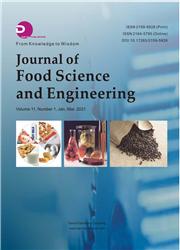Evaluation of the “Harmony/Balance Value” on the Development of the Sensorial Quality of EVOO—Experiences in Germany and Europe
引用次数: 1
Abstract
Since 2015 the methodology of the harmony value in the framework of the official organoleptic assessment has been accredited by the German authorities. It initiated additional background for this parameter which is set on top of the Official Paneltest (Standard IOC/T15/Reg. (EWG) 2568/91 in its actual version) which classifies Olive oil in the relevant classifications “extra virgin”, “virgin” or “virgin lampante”. This study will proof the possible accuracy of this additional parameter “harmony/balance” and the benefits which arise with this additional parameter for all stakeholders. The German Olive Oil Panel (DOP) is practicing this extended methodology for the sensory evaluation of extra virgin olive oil since 2003. In addition to the verification of the category “extra virgin” the Panel is continuously training for additional descriptors used to appraise the quality-discrimination for this category. But in case the panel decides for a valid median of a defect the panel supervisor (PSV) will set the harmony level to zero. In the focus is the additional attribute called “harmony” (in some world areas called “balance”—both mean a quantification of the specific overall quality with one single parameter) which is responsible for this advancement in the methodological approach. Using “harmony/balance” (H/B) as a quality-factor, the discrimination between bad, average, good, very good and premium quality within the category of EVOO became possible. “Harmony” includes olfactory, tactile and kinesthetic stimuli and is evaluated on a bipolar 100 mm scale, which leads to this parameter from “average” in the center to “complex/harmonious” on one side or to “totally disharmonious” on the other side. In the study at hand we are able to prove the development of qualities in the framework of the accredited Panel in German speaking countries over more than 10 years. In this study the development of the increasing quality can be proved in yearly figures of the DOP. The trend could be disturbed however in case of climatological circumstances or orders from outside Germany with over proportional low qualities. The official organoleptic assessment method of IOC/EC separates defect free from defected olive oils and is marking the olive oils with a relevant label of classification (EV, V, Lampant). The additional step to evaluate the harmony value—carried out by the same panel during the same procedure—is quantifying the category of EVOO in relevant quality sectors. This study shows on one side the progress of this method in German speaking countries and their supporting companies. On the other side it revealed the quality problems which arise in markets like the private label/low price (PL/LP) sections in other countries of the European Union. This important market segment covers today about 75%-80% of the market. The IGO study (2015) proved that from 70 samples out of 16 European countries 58.5% (41 samples) have been analyzed as defect; only 41.5% (29 samples) matched the classification EVOO. And from these 29 samples 18 have been evaluated with the additional parameter “harmony/balance” as “lower standard” or “not sufficient”. The long experience with this additional parameter is able to stabilize and quantify the quality of EVOO in favor of all stakeholders.“和谐/平衡价值”对EVOO感官品质发展的评价——德国和欧洲的经验
自2015年以来,德国当局认可了官方感官评估框架中的和谐值方法。它为该参数启动了额外的背景,该参数设置在官方小组测试(实际版本的标准IOC/T15/Reg.(EWG)2568/91)之上,该测试将橄榄油分为“特级初榨”、“初榨”或“初榨lampante”。这项研究将证明这个额外参数“和谐/平衡”的可能准确性,以及这个额外参数对所有利益相关者产生的好处。自2003年以来,德国橄榄油专家组(DOP)一直在采用这种扩展方法对特级初榨橄榄油进行感官评估。除了核实“特级处女”类别外,专家小组还在继续培训用于评估这一类别质量歧视的其他描述符。但是,如果小组决定缺陷的有效中位数,小组主管(PSV)将把和谐水平设置为零。重点是被称为“和谐”的附加属性(在一些世界领域被称为”平衡“——两者都意味着用一个参数量化特定的整体质量),这是方法论方法进步的原因。使用“和谐/平衡”(H/B)作为质量因素,EVOO类别中的差、平均、好、非常好和优质之间的区别成为可能。“和谐”包括嗅觉、触觉和动觉刺激,并在双极性100毫米尺度上进行评估,这导致该参数从中心的“平均”变为一侧的“复杂/和谐”或另一侧的“完全不和谐”。在手头的研究中,我们能够证明在德语国家认证小组的框架内,10多年来质量的发展。在这项研究中,DOP的年度数据可以证明质量不断提高的发展。然而,如果气候环境或来自德国以外地区的订单质量过低,这一趋势可能会受到干扰。IOC/EC的官方感官评估方法将无缺陷橄榄油与有缺陷橄榄油分开,并在橄榄油上标记相关的分类标签(EV、V、Lampant)。评估和谐值的另一个步骤——由同一小组在同一程序中进行——是量化相关质量部门的EVOO类别。这项研究一方面显示了这种方法在德语国家及其支持公司中的进展。另一方面,它揭示了欧盟其他国家的自有品牌/低价(PL/LP)部分等市场中出现的质量问题。这一重要的细分市场目前占据了约75%-80%的市场份额。IGO研究(2015)证明,在16个欧洲国家的70个样本中,58.5%(41个样本)被分析为缺陷;只有41.5%(29个样本)符合EVOO分类。从这29个样本中,有18个样本被评估为“较低标准”或“不充分”的附加参数“和谐/平衡”。该附加参数的长期经验能够稳定和量化EVOO的质量,有利于所有利益相关者。
本文章由计算机程序翻译,如有差异,请以英文原文为准。
求助全文
约1分钟内获得全文
求助全文

 求助内容:
求助内容: 应助结果提醒方式:
应助结果提醒方式:


